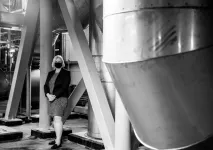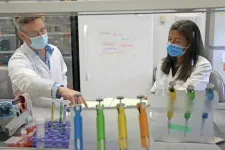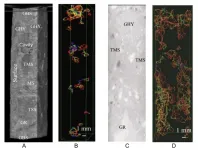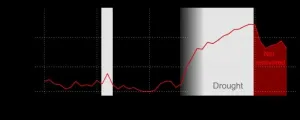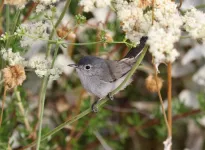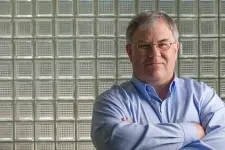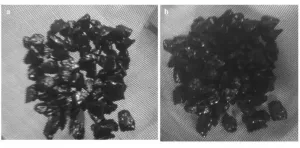(Press-News.org) UNIVERSITY PARK, Pa. -- A plant cell wall's unique ability to expand without weakening or breaking--a quality required for plant growth--is due to the movement of its cellulose skeleton, according to new research that models the cell wall. The new model, created by Penn State researchers, reveals that chains of cellulose bundle together within the cell wall, providing strength, and slide against each other when the cell is stretched, providing extensibility.
The new study, which appears online May 14 in the journal Science, presents a new concept of the plant cell wall, gives insights into plant cell growth, and could provide inspiration for the design of polymeric materials with new properties.
"For a long time, the prevailing concept of a plant cell wall has been that of a gel that is reinforced by cellulose fibers, with the stiff cellulose rods acting like steel rebar in cement," said Daniel Cosgrove, professor of biology at Penn State and senior author of the paper. "However, we determined that cellulose chains instead stick to each other to form a network of cellulose bundles, which provides a lot more mechanical strength than disconnected rods floating in a gel. And it's the cellulose chains, rather than other components, that limit cell wall expansion, sliding alongside each other like an extension ladder when the cell is stretched."
Previous approaches to modeling plant cell walls were focused either at a scale too large to incorporate the behavior of individual cell components or at a scale too small--at the atomic level--to incorporate actual mechanics of the wall. In this study, the researchers used a coarse-grained computer model at the level of the polymers that make up the cell wall--the strings of cellulose and other sugar molecules that are linked together in long chains. Instead of modeling individual atoms, the researchers represented cellulose microfibers and other components with chains of beads that behave like sticky springs, in order to replicate these components' physical properties.
"Unlike many other models, we also accounted for the molecules' tendency to stick together by modeling the noncovalent bonding between them," said Cosgrove. "This allowed us to investigate the consequence of interactions between the chains."
The team specifically modeled layers of an onion cell wall so that they could compare their modeled values of mechanical characteristics to experiments they conducted with actual onion skins. By stretching the onion cell walls in several ways and using molecular insights from the model, they explored the structures responsible for the cell wall's unique mechanical characteristics.
"Plant cells walls are unique because they must be very strong to help protect and support the plant and very extensible because they must expand when the plant grows," said Yao Zhang, postdoctoral researcher in biology at Penn State and first author of the paper. "We found that the cellulose microfibers carry most of the stress and are key to the cell wall maintaining both its strength and extensibility."
The researchers determined that individual cellulose fibers align with and stick to each other, forming a network of bundles. Microfibers in a bundle straighten and can slide along each other, in a type of telescopic action, when the cell is stretched, transmitting forces between them and resulting in the cell's extension.
"For a long time, researchers have measured the mechanical properties, like stress and strain, of plant cell walls and how these properties change under drought and other conditions," said Cosgrove. "But until now, we lacked a molecular description of what was going on at the molecular level to understand these measurements. In this study, we clarified the roles of the various components in the plant cell wall and provide a quantitative framework for interpreting experiments used in plant research."
The insights from this study may be particularly useful in future work investigating how plants regulate their cell wall properties, which impacts the speed and the direction of their growth. For example, young stems elongate rapidly in the spring whereas many fruits grow spherically.
The researchers hope to extend their model to simulate cell walls of other plant species and expand it to encompass an entire cell.
"Our technology currently can't match a plant's ability to create such a strong and extensible material," said Yao. "The design of plant cell walls may provide inspiration for the design of green materials with a variety of applications."
INFORMATION:
In addition to Cosgrove and Zhang, the research team at Penn State includes Jingyi Yu, graduate student in plant biology; Xuan Wang, graduate student in plant biology at the time of the research; Daniel Durachko, research assistant at the time of the research; and Sulin Zhang, professor of engineering science and mechanics and of bioengineering.
The research was supported in part by the Center for Lignocellulose Structure and Formation, an Energy Frontier Research Center funded by the U.S. Department of Energy.
Curiosity is the motivational drive for exploring and investigating the unknown and making new discoveries. It is as essential and intrinsic for survival as hunger. Until recently, the brain mechanisms underlying curiosity and novelty seeking behavior were unclear. However, researchers from the Netherlands Institute for Neuroscience have now discovered a new brain circuit underlying curiosity and novelty seeking behavior. The results have been published in the scientific journal Science.
Curiosity, hunger and appetitive aggression drive three different goal-directed behaviors: novelty seeking, food eating and hunting. In animals these behaviors are composed of similar actions. This similarity of actions has made it challenging ...
A group of the world's leading experts in the transmission of airborne pathogens is calling for a tightened regulatory system to control air quality in buildings - as a way of reducing the spread of covid-19 and other illnesses.
Writing in the journal Science, the 40 scientists say: "A paradigm shift is needed on the scale that occurred when Chadwick's Sanitary Report in 1842 led the British government to encourage cities to organise clean water supplies and centralised sewage systems.
"In the 21st century we need to establish the foundations to ensure that the air in our buildings is clean with a significantly reduced ...
Epidemic. Pandemic. These terms have become second nature to us, popping up in everyday conversation, and for good reason -- COVID-19 is the latest pandemic to pose a threat to humanity.
But in recent months, far less attention has been paid to another widely spread problem that has been proliferating since the late 1970s: Lyme disease.
Lyme disease is the most reported vector-borne disease in the country. Over the past 20 years, the United States has experienced a dramatic increase in both the number of reported cases and the geographic distribution of the disease. In Virginia, the disease is transmitted by blacklegged ticks, which are infected with the Lyme disease-causing bacterium Borrelia ...
Scientists reveal that the deterioration of modern concrete and asphalt structures is due to the presence of trace quantities of organic matter in these structures.
Cement and asphalt are vital to modern construction materials; cement is used for the construction of various buildings and structures, while asphalt is primarily used for highways and runways. They have been widely used for these purposes since the 1800s. It has been observed modern concrete structures and asphalt structures tend to deteriorate much faster than historical structures, but the reason for this phenomenon was unknown.
A team of scientists from six institutions, including Akihiro ...
One-third of the water catchments included in a Victorian study had not recovered from a severe drought nearly eight years later, Australian-first research from Monash University shows.
Globally, science holds the common view that rivers and underground water supplies eventually replenish following periods of severe drought or flood.
This study, led by Dr Tim Peterson from Monash University's Department of Civil Engineering and published today in the prestigious international journal Science, is the first in the world to challenge this widely held view.
Researchers used statistical ...
A new approach to genomic species delineation could impact policy and lend clarity to legislation for designating a species as endangered or at risk.
The coastal California gnatcatcher is an unassuming little gray songbird that's been at the epicenter of a legal brawl for nearly 28 years, ever since U.S. Fish and Wildlife Service listed it as threatened under the Endangered Species Act.
Found along the Baja California coast, from down south in El Rosario, Mexico to Long Beach, Calif., its natural habitat is the rapidly declining coastal sagebrush that occupies prime, pristine real estate along the West Coast. When this particular gnatcatcher, Polioptila californica, was granted protection, the region's real estate developers went to court to get it delisted. ...
Viruses require the resources of an infected cell to replicate and then infect further cells, and transfer to other individuals. One essential step in the viral life cycle is the production of new viral proteins based on the instructions in the viral RNA genome. Following these construction plans, the cell's own protein synthesis machine, called the ribosome, produces the viral proteins.
In the absence of viral infection, the ribosome moves along the RNA in strictly defined steps, reading three letters of RNA at a time. This three-letter code defines the corresponding amino acid that is being attached to the growing protein. It almost never happens that the ribosome slips one or two RNA letters forward or backward instead of following the regular three-letter steps. When such a slip ...
Irvine, CA - May 13, 2021 - A new University of California, Irvine-led study finds low serum levels of the sugar N-acetylglucosamine (GlcNAc), is associated with progressive disability and neurodegeneration in multiple sclerosis (MS).
The study, done in collaboration with researchers from Charité - Universitätsmedizin Berlin, Germany, and the University of Toronto, Canada, is titled, "Association of a Marker of N-Acetylglucosamine With Progressive Multiple Sclerosis and Neurodegeneration," The study was published this week in JAMA Neurology.
The study suggests that GlcNAc, which has been previously shown to promote re-myelination and suppress neurodegeneration in animal models of MS, ...
First co-author, Junior Research Associate of the Rheological and Thermochemical Research Lab Richard Djimasbe, comments, "To obtain bitumen as a half-solid product from heavy oil, you have to extract light fractions, and the rest is non-oxidized bitumen. Because of the relatively low ratio of light fractions in heavy oil, it's a simple and cheap way of bitumen production. The method allows for rational use of both heavy oil and light oil."
Lab Head Mikhail Varfolomeev adds, "One of the priorities of our World-Level Research Center in Liquid Hydrocarbons is the use of heavy oils, which constitute the majority of reserves both in Russia and in the world. One of the most important parts of this is extraction and refining of heavy ...
Laura Riesenberg was visiting a local amusement park with three of her children when she suffered a massive heart attack.
"I was down for about 20 minutes and they defibrillated me twice on site, possibly three times," she says. "Obviously, I was unaware of it. I know from reading the reports what happened."
"I was extremely fortunate that someone found me within seconds of collapsing," says Riesenberg. "Had it happened anywhere else I wouldn't be talking to you right now. If I had been in the basement doing laundry, I would have been in trouble."
The 51-year-old Loveland, Ohio, resident ...
